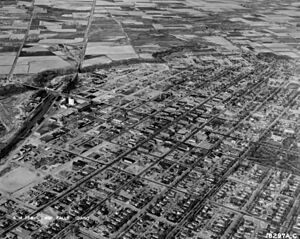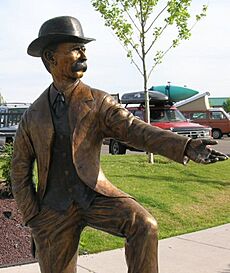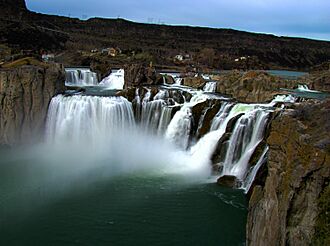Twin Falls, Idaho facts for kids
Quick facts for kids
Twin Falls, Idaho
|
||
|---|---|---|
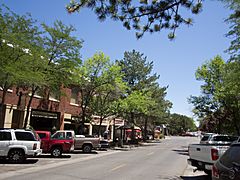
Downtown Twin Falls in 2016
|
||
|
||
| Motto(s):
People Serving People
|
||
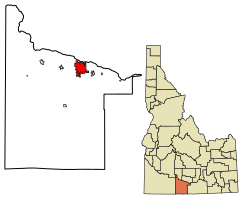
Location of Twin Falls in Twin Falls County, Idaho.
|
||
| Country | United States | |
| State | Idaho | |
| County | Twin Falls | |
| Incorporated | April 12, 1905 | |
| Government | ||
| • Type | Council-manager | |
| Area | ||
| • Total | 19.47 sq mi (50.43 km2) | |
| • Land | 19.36 sq mi (50.13 km2) | |
| • Water | 0.11 sq mi (0.30 km2) | |
| Elevation | 3,730 ft (1,140 m) | |
| Population
(2020)
|
||
| • Total | 51,807 | |
| • Estimate
(2022)
|
54,300 | |
| • Density | 2,593.49/sq mi (1,001.34/km2) | |
| Time zone | UTC-7 (MST) | |
| • Summer (DST) | UTC-6 (MDT) | |
| ZIP Code |
83301 (street addresses)
83303 (PO Boxes) |
|
| Area code(s) | 208, 986 | |
| FIPS code | 16-82810 | |
| GNIS feature ID | 2412120 | |
| Interstate | ||
| U.S. Route(s) | ||
| Website | http://www.tfid.org | |
Twin Falls is a city in Idaho, United States. It is the biggest city in Twin Falls County. In 2020, about 51,807 people lived there.
Twin Falls is in the Magic Valley region. It is the largest city in a 100-mile (160 km) area. It is a main center for business in south-central Idaho and parts of northeastern Nevada. The city is on a wide flat area at the edge of the Snake River Canyon.
This is where the famous daredevil Evel Knievel tried to jump across the canyon in 1974. He used a special steam-powered rocket. The spot where he jumped is northeast of the city. It is between Shoshone Falls and the Perrine Bridge.
Contents
History of Twin Falls
Scientists found old tools near Twin Falls in 1959. These tools show that people lived here a very long time ago. Later, Native American tribes like the Northern Shoshone and Bannock lived in the area.
The first Europeans to visit were part of a group led by Wilson Price Hunt in 1811. They tried to find a water path to the west. But their trip had problems on the Snake River.
In 1812, Robert Stuart led a successful trip back east. His path became the famous Oregon Trail. A middle school in Twin Falls is named after him today.
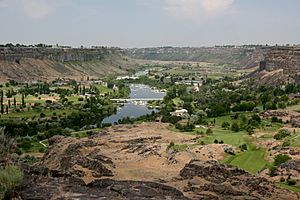
The first lasting settlement was a stop for travelers in 1864. It was at Rock Creek. By 1890, some farms were in the Snake River Canyon. But it was hard to get water to the dry land around them.
In 1900, I. B. Perrine started a company to build canals for irrigation. This system would bring water to the farms. In 1903, Perrine got money to build a dam on the Snake River. This dam was called Milner Dam. It was finished in 1905.
The Milner Dam made it possible to farm on the dry land. Because of this, Perrine is known as the founder of Twin Falls. The city of Twin Falls was started in 1904. It was a planned community. Money from selling land helped build the irrigation canals.
Twin Falls became a village on April 12, 1905. The city is named after a waterfall nearby. In 1907, Twin Falls became the main city of the new Twin Falls County.
After the dam, farming grew a lot in Idaho. Twin Falls became a big center for farming businesses. It processed crops like beans and sugar beets. By 1960, Twin Falls was one of Idaho's largest cities.
In September 1974, Evel Knievel tried to jump the Snake River Canyon. He used a special rocket bike. Millions watched on TV. But his parachute opened too early because of strong winds. The jump failed. You can still see the launch ramp on the canyon's edge.
In recent years, Twin Falls has grown by adding different types of businesses. Major companies like Glanbia have operations here. In 2010, a call center company called C3 opened. It created many jobs.
Education in Twin Falls
Twin Falls has good schools for all ages.
Higher Education
College of Southern Idaho (CSI) is a large community college in Twin Falls. It is in the northwest part of the city. Idaho's three state universities also offer classes at CSI. The nursing program at CSI has a modern building. The CSI men's basketball team won a national championship in 2011.
Schools for Kids
Public schools in Twin Falls are run by the Twin Falls School District.
High Schools
- Canyon Ridge High School (grades 9-12)
- Twin Falls High School (grades 9-12)
- Magic Valley High School (alternative high school, grades 9-12)
Middle Schools
- O'Leary Middle School (grades 6-8)
- Robert Stuart Middle School (grades 6-8)
- Bridge Academy (alternative, grades 6-8)
- South Hills Middle School (grades 6-8)
Elementary Schools
- Bickel Elementary School (grades K-5)
- Harrison Developmental Preschool
- Harrison Elementary School (grades K-5)
- I.B. Perrine Elementary School (preschool and K-5)
- Lincoln Elementary School (grades K-5)
- Morningside Elementary School (grades K-5)
- Oregon Trail Elementary School (grades K-5)
- Pillar Falls Elementary School (grades K-5)
- Sawtooth Elementary School (grades K-5)
- Rock Creek Elementary School (grades K-5)
- St. Edward's Catholic School (grades K-8)
There are also private schools like Lighthouse Christian School and Twin Falls Christian Academy. Xavier Charter School is another option.
Economy and Jobs
Twin Falls is the fastest-growing city in south-central Idaho. It is the seventh-largest city in the state. The city's economy is strong and growing.
Many food companies are in Twin Falls. Glanbia Foods makes cheese here. Falls Brand is another food company known for its sausages. The Amalgamated Sugar Company makes sugar. Lamb Weston has a plant that processes food.
The College of Southern Idaho is also a big employer. Many students from other states live in the college dorms.
Twin Falls has seen a lot of new businesses open since 2006. A new Walmart Supercenter opened in 2009. In 2010, C3, a customer call center, opened and created many jobs.
A new movie theater, Magic Valley Cinema 13, was built. It has special D-BOX seating. A new hospital, St. Luke's Magic Valley, opened in 2011. All 186 rooms are private.
In 2012, Chobani Yogurt Company opened the world's largest yogurt factory in Twin Falls. This created 300 new jobs.
Media and News
Twin Falls has its own daily newspaper, the Times-News.
You can also watch several TV stations:
- KMVT (CBS and CW)
- KSVT-LD (FOX and MyNetworkTV)
- KIPT (PBS)
- KXTF (TCT)
- KTFT (NBC)
- KSAW-LD (ABC)
- KYTL (Independent)
Many radio stations broadcast in the Twin Falls area. They play different types of music and news.
Getting Around Twin Falls
Twin Falls is not directly on a major interstate highway. But it is served by U.S. Route 30 and U.S. Route 93. You can reach Interstate 84 by crossing the canyon on the Perrine Bridge.
Limited flights are available at Magic Valley Regional Airport. You can fly to Salt Lake City.
In 2023, Twin Falls started a new public transportation system called Ride TFT. It is a Microtransit system. You can book rides within the city. It quickly became very popular.
Geography and Nature
Twin Falls has a total area of about 18.16 square miles (47.03 km²). A small part of this is water.
The Snake River Canyon forms the northern edge of the city. Three waterfalls are close by. Shoshone Falls is about 5 miles (8 km) east of the city. Pillar Falls is upstream from the Perrine Bridge. Twin Falls, which the city is named after, is also upstream from Shoshone Falls.
Shoshone Falls is 213 feet (65 m) high. This makes it 46 feet (14 m) taller than Niagara Falls.
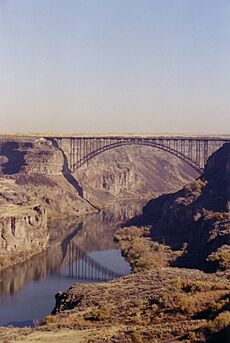
The Perrine Bridge crosses the Snake River Canyon just north of Twin Falls. It is one of the few places in the world where BASE jumping is legal. In 2005, Miles Daisher set a world record by jumping off the bridge 57 times in 24 hours. In 2006, Dan Schilling jumped 201 times in 21 hours for charity.
Climate
Twin Falls has a dry climate. Summers are warm, and winters are cold. Temperatures can reach 90°F (32°C) about 23 days a year. It rarely gets hotter than 100°F (38°C). In winter, Twin Falls gets about 24.2 inches (61 cm) of snow each year. But heavy snowfalls are not common. Summer and autumn are very dry. Less than 1 inch (2.5 cm) of rain falls each month from June to October.
Population and People
In 2010, about 44,125 people lived in Twin Falls. The city has grown a lot over the years.
- 1910: 5,258 people
- 1920: 8,324 people
- 1930: 8,787 people
- 1940: 11,851 people
- 1950: 17,600 people
- 1960: 20,126 people
- 1970: 21,914 people
- 1980: 26,209 people
- 1990: 27,591 people
- 2000: 34,469 people
- 2010: 44,125 people
- 2020: 51,807 people
In 2010, about 27% of the people were under 18 years old. The average age was 31.9 years.
Fun Facts
Twin Falls was ranked number one on Livability.com's list of "Best 10 Places to Defy Death." This is because of the BASE jumping from the Perrine Bridge.
Famous People from Twin Falls
Many interesting people have connections to Twin Falls:
- Bruce Bastian (born 1948) - He helped start the WordPerfect Software Company.
- Christina Hendricks (born 1975) - A famous actress who grew up here.
- Dallin H. Oaks (born 1932) - A leader in the LDS Church.
- Melvin Schwartz (1932–2006) - A scientist who won a Nobel Prize.
- Addison T. Smith (1862–1956) - A U.S. Congressman. A street is named after him.
Some famous musicians also spent time in the Twin Falls area:
- Gary Puckett
- Paul Durham of Black Lab
- Nikki Sixx of Mötley Crüe
- Doug Martsch of Built to Spill
See also
 In Spanish: Twin Falls (Idaho) para niños
In Spanish: Twin Falls (Idaho) para niños




